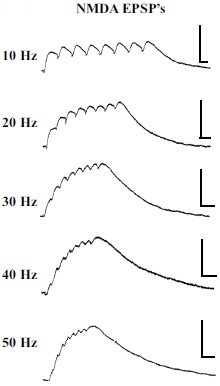Overview
- Traynelis, S.F. et al. (2010) Pharmacol. Rev. 62, 405.
- Honore, T. et al. (1988) Science 241, 701.
- Armstrong, N. and Gouaux, E. (2000) Neuron 28, 165.
 Alomone Labs DNQX inhibits GluA1 channels expressed in Xenopus oocytes.Time course of current reversible inhibition by 2, 10 and 50 µM DNQX (#D-131) (at -80 mV) in the presence of 100 μM glutamate. Amplitude change as a result of the application of raising concentrations of DNQX (perfusion duration indicated by the horizontal bar, concentration as indicated).
Alomone Labs DNQX inhibits GluA1 channels expressed in Xenopus oocytes.Time course of current reversible inhibition by 2, 10 and 50 µM DNQX (#D-131) (at -80 mV) in the presence of 100 μM glutamate. Amplitude change as a result of the application of raising concentrations of DNQX (perfusion duration indicated by the horizontal bar, concentration as indicated).
The first widely used competitive AMPA receptor antagonists were quinoxalinediones (CNQX, DNQX, NBQX), which were highly selective over NMDA receptors but antagonized kainate receptors. Surprisingly, association of AMPA receptors with TARP auxiliary subunits converts DNQX from an antagonist to a weak partial agonist. DNQX induces partial domain closure, consistent with the activity of a partial agonist. DNQX interacts with residues primarily within domain D1 of the clamshell, thereby depriving the agonist of its initial contact sites with the open cleft of the binding pocket1.
The concentrations that inhibit 50% of AMPA binding (IC50) for DNQX is 0.50 ± 0.10 µM, and about one-fifth as effective at kainate binding sites, 2.0 ± 0.1 µM in rat cortical membranes2. The IC50 of DNQX is 1 µM in a crystal structure of the GluR2 ligand binding core3.

Alomone Labs DNQX blocks non-NMDA EPSPs in mouse layer V neurons.Representative traces showing NMDA receptor-mediated EPSPs following 20 µM DNQX (#D-131) application. Traces are shown for different stimulation frequency.Adapted from Leyrer-Jackson, J.M. and Thomas, M.P. (2017) Physiol. Rep. 5, e13499. with permission of The Physiological Society and the American Physiological Society.

